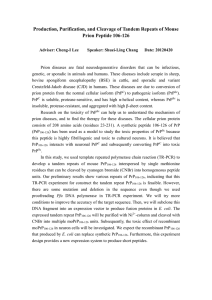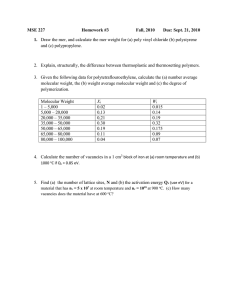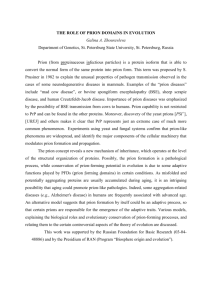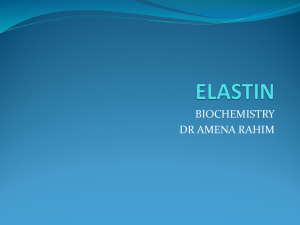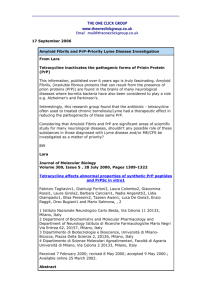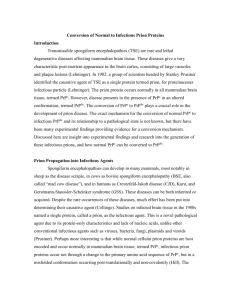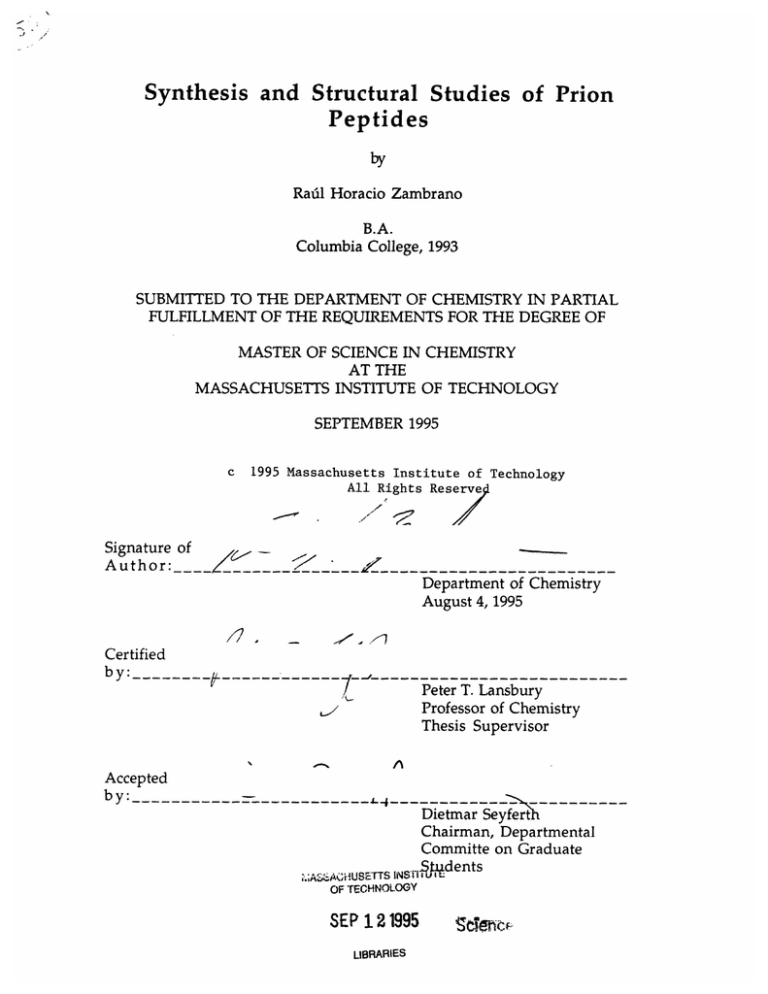
Synthesis and Structural Studies of Prion
Peptides
by
Ral Horacio Zambrano
B.A.
Columbia College, 1993
SUBMITTED TO THE DEPARTMENT OF CHEMISTRY IN PARTIAL
FULFILLMENT OF THE REQUIREMENTS FOR THE DEGREE OF
MASTER OF SCIENCE IN CHEMISTRY
AT THE
MASSACHUSETTS INSTITUTE OF TECHNOLOGY
SEPTEMBER 1995
c
1995 Massachusetts
Institute
of Technology
All Rights Reserv
Signature of
Author:'------___/_,--___
__
_
Department of Chemistry
August
4, 1995
X, _
..
by:-_____________
-
Certified
Peter T. Lansbury
Professor of Chemistry
Thesis Supervisor
~,'
A
Accepted
by:___________… __________…-4…
Dietmar Seyfert
Chairman, Departmental
Committe on Graduate
.';A&;-LUSEI:,TSINSiutIdents
OF TECHNOLOGY
SEP 121995
LIBRARIES
Synthesis and Structural Studies of Prion
Peptides
by
Ratil H. Zambrano
Submitted to the Department of Chemistry
on August 4, 1995 in Partial Fulfillment of the Requirements for the Degree of
Master of Science in Chemistry
ABSTRACT
The ubiquitously 1 3 C-labeled dipeptide tyrosyl lysine was synthesized
for use as a model compound in examining radio frequency driven
recoupling solid state nuclear magnetic resonance spectroscopy as a possible
tool in elucidating the structure of the prion protein.
One, two, and three repeats of the octarepeat region (proline-histidineglycine-glycine-glycine-tryptophan-glycine-glutamine) of the prion protein
were synthesized and preliminary circular dichroism (CD) studies were
performed. A slight concentration dependence was observed and the
observed CD absorbances did not correspond to any known structure.
Thesis Supervisor: Peter T. Lansbury Jr
Title: Associative Professor of Chemistry
2
Table of Contents
Chapter 1
Introduction
Structure of PrP
Chapter 2
Solid State Nuclear Magnetic Resonance Spectroscopy
Radio Frequency Driven Recoupling (RFDR)
Synthesis of the Dipeptide Tyrosyl Lysine
Conclusion
Experimental
Chapter 3
Octarepeat Region of the PrP Protein
Experimental
CD
Results
Discussion
3
Chapter 1
Introduction
The class of diseases known as the transmissible spongiform
encephalopathies (TSE's) are hypothesized to be caused by infective pathogens
known as prions (Chesebro, 1991). TSE's affect both humans and animals.
Human TSE's include kuru, Creutzfeldt-Jakob disease (CJD), fatal familial
insomnia (FFI), and Gerstmann-Striussler-Scheinker syndrome (GSS).
Scrapie, bovine spongiform encephalopathy (BSE), and transmissible mink
encephalopathy are some of the animal TSE's. The TSE's, also known as
prion diseases, are all fatal. A unique feature of the prion diseases is that they
are inheritable and transmissible (Stahl, & Prusiner, 1991).
It is postulated that prions, proteinaceous infectious particles, are
composed of a host derived protein, PrPC. The protein consists of 254 amino
acids (Figure 1).
SHaPrP MANLSYWILALFVAMWTDVGLCKKRPKPGGWNTGGSRYPG
QGSPGGGNRYPPQGGGTWGQPHGGGWGQPHGGGGWGQPHGGGWGQ
PHGGGWGQGGGTHNQWNKPSKPKTNMKHMAGAAAAGAVVGGLGG
YMLGSAMSRPMMHFGNDWEDRYYRENMNRYPNQVYYRPVQYNNQN
NFVHDCVNITIKQHTVTTTTKGENFTETDIKIMERVVEQMCTTQYQKESQ
AYYDGRRSSAVLFSSPPVILLISFLIFLMVG
Figure 1: Sequence of the prion protein in Syrian hamster.
4
The protein is made up of a signal peptide cleaved during biosynthesis, five
octapeptide and two hexapeptide repeats rich in Gly and Pro, a
transmembrane like sequence, a possible amphipathic helix, and a
hydrophobic terminal sequence (Figure 2).
Signal
Peptide
Gly Pro
Repeats
Transmembrane
Amphipathic
Hydrophobic
Region
Helix
Terminal
Sequence
Figure 2: Schematic of PrP
The infectious form of the prion protein, PrPSc, seems to be covalently
identical to PrPC. Although there does not seem to be any covalent difference
between PrPC and PrPSc, there are some physical differences between the two
isoforms. PrPC is significantly more soluble than PrPSc. PrPC is more
sensitive to protease digestion than PrPSc. PrPSc is only partially degraded by
proteinase K (PK) under conditions that completely degrade PrPC. The PK
treatment of PrPSc removes about 67 amino acids from the amino terminus
of PrP. It should be noted that cleavage at the N-terminus does not affect
infectivity (Prusiner, 1991).
The function of PrP in cells is as of yet unknown. However, it is known
that PrPSc is derived from PrPC. PrP mRNA concentration is highest in the
neurons and does not increase over the course of infection (Chesebro, et al.,
1985). PrPSc is formed after PrPC is anchored to the cell membrane by its
glycosylphosphatidylinositol (GPI) anchor (Caughey, & Raymond, 1991).
Certain mutations in the PrP gene have been linked with GSS and CJD.
The open reading frame of the PrP gene is found on a single exon on the
short arm of human chromosome 20 (Sparkes, et al., 1986). A cytosine to
thymine substitution in the second position of codon 102 causes a proline to
leucine change which segregates with GSS (Hsiao, et al., 1990). A mutation at
5
codon 200 (glutamic acid to lysine) has also been linked to CJD in Libyan Jews
(Goldfarb, et al., 1992). Finally the insertion of several additional octapeptide
repeats has been found to segregate with GSS (Owen, et al., 1991).
Structure of PrP
One structural study of PrPC has been reported using Fourier
Transform Infrared Spectroscopy (FTIR) and Circular Dichroism (CD) (Pan, et
al., 1993). Using FTIR two structural studies of PrPSc have appeared (Caughey,
et al., 1991; Gasset, Baldwin, Fletterick, & Prusiner, 1993) These studies both
correlated structure with infectivity. Implying that the difference between
the two isoforms of the prion may be conformational. Recently, PrPC has
been converted to PrPSc in vitro supporting the idea that the non- and
infectious forms differ only in their 3-dimensional structure (Kocisko, et al.,
1994). Therefore, in order to understand the mechanism of interconversion,
which may be essential to the process of infection, it is necessary to elucidate
the structures of PrPC and PrPSc.
6
Caughey, B., & Raymond, G. J. (1991).The Scrapie-associated Form of PrP Is
Made from a Cell Surface Precursor That Is Both Protease-and PhospholipaseSensitive. The Journal of Biological Chemistry, 266(27), 18217-18223.
Caughey, B. W., Dong, A., Bhat, K. S., Ernst, D., Hayes, S. F., & Caughey, W. S.
(1991). Secondary Structure Analysis of the Scrapie-Associated Protein PrP 2730 in Water by Infrared Spectroscopy. Biochemistry, 30 7672-7680.
Chesebro, B., Race, R., Wehrly, K., Nishio, J., Bloom, M., Lechner, D.,
Bergstrom, S., Robbins, K., Mayer, L., Keith, J. M., Garon, C., & Haase, A.
(1985). Identification of scrapie prion protein-specific mRNA in scrapieinfected and uninfected brain. Nature, 315, 331-333.
Chesebro, B. W. (1991). Transmissible Spongiform Encephalopathies Scrapie,
BSE and Related Disorders. New York: Springer-Verlag, 288.
Gasset, M., Baldwin, M. A., Fletterick, R. J., & Prusiner, S. B. (1993).
Perturbation of the secondary structure of the scrapie prion protein under
conditions that alter infectivity. Proceedings of the National Academy of
Sciences, 90, 1-5.
Goldfarb, L. G., Petersen, R. B., Tabaton, M., Brown, P., LeBlanc, A. C.,
Montagna, P., Cortelli, P., Julien, J., Vital, C., Pendelbury, W. W., Haltia, M.,
Wills, P. R., Hauw, J. J., McKeever, P. E., Monari, L., Schrank, B., Swergold, G.
D., Autilio-Gambetti, L., Gajdusek, D. D., Lugaresi, E., & Gambetti, P. (1992).
Fatal Familial Insomnia and Familial Cretzfeldt-Jakob Disease: Disease Pheno
type Determined by a DNA Polymorphism. Science, 258, 806-808.
Hsiao, K. K., Scott, M., Foster, D., Groth, F. D., DeArmond, S. J., & Prusiner, S.
B. (1990). Spontaneous Neurodegeneration in Transgenic Mice with Mutant
Prion Protein. Science, 250, 1587-1590.
Kocisko, D. A., Come, J. H., Priola, S. A., Chesebro, B., Raymond, G. J.,
Lansbury Jr, P. T., & Caughey, B. (1994).Cell-free formation of protease-
resistant prion protein. Nature, 370, 471-474.
Owen, F., Poulter, M., Collinge, J., Leach, M., Shah, T., Lofthouse, R., Chen, Y.,
Crow, T. J., Harding, A. E., Hardy, J., & Rossor, M. N. (1991). Insertions in the
Prion Protein Gene in Atypical Dementias. Experimental Neurology, 112, 240242.
Pan, K., Baldwin, M., Nguyen, J., Gasset, M., Serban, A., Groth, D., Mehlhorn,
I., Huang,
Z., Fletterick,
R. J., Cohen,
F. E., & Prusiner,
S. B. (1993). Conversion
of ca-helices into -sheets features in the formation of the scrapie proteins.
Proceedings of the National Academy of Sciences. USA, 90, 10962-10966.
7
Prusiner, S. B. (1991). Novel Properties and Biology of Scrapie Prions. In B. W.
Chesebro (Ed.), Transmissible Spongiform Encephalopathies Scrapie. BSE and
Related Disorders (pp. 233-257). New York: Springer-Verlag.
Sparkes, R. S., Simon, M., Cohn, V. H., Fournier, R. E. K., Lem, J., Klisak, I.,
Heinzmann, C., Blatt, C., Lucero, M., Mohandas, T., DeArmond, S. J.,
Westawat, D., Prusiner, S. B., & Weiner, L. P. (1986). Assignment of the
human and mouse prion protein genes to homologous chromosomes.
Proceedings the National Academy of Sciences, 83, 7358-7362.
Stahl, N., & Prusiner, S. B. (1991). Prions and prion proteins. The FASEB
Journal, 5, 2799-2807.
8
Chapter 2
Solid State Nuclear Magnetic Resonance Spectroscopy
Radio Frequency Driven Recoupling (RFDR)
In trying to elucidate the structure of PrPSc only low resolution
methods have been applied, as PrPSc forms an insoluble, non-crystalline,
aggregate that is classified as amyloid(Kelly, & Lansbury, 1994) . As a result,
traditional methods of structure elucidation such as X-ray crystallography and
solution nuclear magnetic resonance spectroscopy cannot be applied.
Therefore, solid state nuclear magnetic resonance spectroscopy (SSNMR) has
been considered for application to this problem (Griffiths, & Griffin, 1993). In
particular, a new SSNMR method called radio frequency driven recoupling
(RFDR), developed by Robert Griffin at the Massachusetts Institute of
Technology, is being examined for application to the prion(Griffiths, et al.,
1993).
RFDR is the solid state NMR equivalent of 2D Nuclear Overhauser
effect spectroscopy (NOESY) and total correlation spectroscopy (TOCSY).In
NOESY and TOCSY proton to proton spatial and connective information is
acquired (Derome, 1987). In RFDR carbon-13 to carbon-13 or carbon-13 to
nitrogen-15 spatial and connective information is acquired. RFDR is an
improvement over the Rotational Resonance (R2 ) technique previously
employed, as R2 measures one distance between nuclei at a time and the
spinning speed of the sample must be maintained within stringent limits for
distances to be acquired (Griffiths, et al., 1993).
To examine the effectiveness and accuracy of the RFDR method a
model compound whose intermolecular carbon to carbon and carbon to
nitrogen distances were known was needed. The dipeptide tyrosine lysine
(Figure 3) was chosen as this model compound as its crystal structure was
known.(Urpi, Coll, & Subirana, 1988). Therefore, a synthesis of tyrosine lysine
from the commercially available ubiquitously carbon-13 labeled amino acids
tyrosine and lysine was developed.
9
'CI
/
/
NH 3 +CI'
Figure 3 : Dipeptide Tyrosine Lysine (Figure drawn to represent three
dimensional crystal structure)
Synthesis of the DiveDtide Tvrosvl Lvsine
r
r
_
-
i
The following synthetic scheme was developed using known
chemistry to synthesize carbon-13 labeled tyrosine lysine.
10
NH
HCI
H N
CuCO3(Oi)
NH2
NH,
COO
:i
2
H20
reflux
COOH
NHCBZ
NH,
COO
:,
C::
1. 2M NaOI
2. CBZ-C1
3. HCL
COO
NH
NHCBZ
CBZHN
I
TsC)H
CBZHN
BnOC)
2S
I1)
Toluene
OOC
HN CI
130 °C
.
BnOOC
OBn
.lI
COOH
,NH 2
'uSO4 5H,()
a)H
IN-"j
lnBr
HO
COO-
HO'
11
H,N'TsO
COO-
OBn
-OOC
NH 2
COOH
HCL
BnO
BnO
H
OH
BnO
N,
1. NaOH
2. CBZ-CI
COC
Cyanuric Fluoricle
Pyridline
OBn
OBn
H
BnO.
N
COF
OBn
12
H
BnO,,
N
CBZHN
COF
Base
+
0
CH 3 CN
BnOOC
OBn
H
BnO'i
N
0OOBn
O
H 3 N+TsO
OBn
CBZHN
BnO¥
NH 3+AcO
TFA
COOBn
TFMSA
0
OBn
N.
H
-
COOH
OH
The synthesis of tyrosyl lysine (YK) was much more challenging than first
expected. The protecting groups chosen for the synthesis of YK were all benzyl
carbamates, esters, and ethers. These protecting groups were chosen with the
purpose of a simple final reaction and purification. It was hoped that the
13
protected YK (Figure 3A) could be deprotected in one step through catalytic
palladium hydrogenation.
BnO
COOBn
O
OBn
Figure 3A: Protected YK
As it turned out hydrogenation as a deprotection method was not possible as
the protected YK was not soluble in any of the typical hydrogenation solvents.
However, as it was later discovered trifluoromethanesulfonic (TFMSA) acid
cleavage was very effective in the deprotection of YK.
Protection of the individual amino acids in YK also proved to be very
challenging as both Y and K have three functionalities. First attempts at
protecting the individual amino acids involved orthogonal protection of the
amino and carboxy moieties of the amino acid followed by protection of
either the amino or hydroxy amino acid side chain. These attempts generated
very low yielding and impure products as multiple reactions and
purifications were required. Eventually, it was decided to use copper
chemistry to protect the amino and carboxy termini of the amino acids as the
procedure reduced both the number of reactions and purifications.
The coupling reaction between the tyrosine and lysine produced side
products that were inseparable from the protected dipeptide. The solution to
this problem turned out to be the use of the acyl fluoride. A method which
produces a very easily purified product as the products of the reaction are the
product, starting materials, and salt.
Conclusion
Tyrosine lysine will now be recrystallized over three months and used
in studies of the effectiveness of RFDR.
14
Experimental*
* Note the carbon spectra that follow are proton decoupled, however, as the
compound is 1 3 C ubiquitously labeled splitting of the carbon signal occurs.
Also proton NMR's will be very broad as the carbons will be coupling to the
hydrogens in addition to the normal hydrogen to hydrogen coupling.
£-N-CBZ-Lysine-O-Benzyl Ester p-toluenesulfonic Acid Salt
CBZHN
BnOOC
I-I3 NsTsO -
2.0 grams (0.0098 mol, 1 eq) of labeled lysine was dissolved in 15 ml of
water and 2.6 grams (0.0108mol, 1.2 eq) of CuCO3(OH)2 added. The solution
was heated to between 85-90 degrees Celsius and refluxed for one hour. The
solution was then filtered to remove excess copper carbonate. The filter was
washed with hot water until the filtrate was colorless. The solution was then
cooled to room temperature. 14.4 ml (0.0288mol, 4 eq) of 2M NaOH was
added to the solution and it was cooled in an ice bath. 2.06 ml (0.0144 mol,
2eq) Benzyloxycarbonyl chloride was then added dropwise over ten minutes
with stirring. After two hours the solution was filtered and 2.5g (0.00334 mol)
of a blue solid was collected by filtration. The solid was dried under vacuum
overnight and ground into a fine powder with a mortar and pestle. The solid
was taken up in 200 ml of water and stirred vigorously as H2S was bubbled
through for thirty minutes. The solution was boiled and filtered hot. The
filtrate was allowed to cool to room temperature at which time e.-N-CBZLysine precipitates out. The -N-CBZ-Lysine was recrystallized multiple times
from fresh water. 296 mg (9.3% yield) of the compound was recovered
(Neuberger, & Sanger, 1943).
£-N-CBZ-Lysine (296 mg, 0.00091mol, 1 eq) was suspended in a mixture
of 2 ml (20 eq) of freshly distilled benzyl alcohol and 2 ml (10 eq) of toluene.
190 mg (0.001 mol, 1.1 eq) of p-toluenesulfonic acid monohydrate was added
and the solution was refluxed overnight. The solution was then added to cold
15
ether (200ml). A precipitate immediately formed and was collected through
filtration. 403 mg (99% yield) of the £-N-CBZ-Lysine-O-benzyl ester ptoluenesulfonic Acid Salt was collected (Bodanszky, & Bodanszky, 1984).
1
The product was identified through NMR (Figure 4 & 5; H NMR
0.9, 1.5, 2.0 (6H, Cp-H,C6-H,Cy-H), 6 2.3 (s, 3H, CH3 ptoluenesulfonic acid), 8 2.6, 3.2 (s, 2H, Ce-H), 6 3.7, 4.3 (s, 1H, Cc-H), 6 5.0 (s, 4H,
benzyl protons), 6 7.0, 7.7 (m, 4H, p-toluenesulfonic acid Ar), 8 7.3 (s, 10H,
Phenyl H); 13 C NMR (CDC13, 60 MHz) 8 21 (m, P C), 6 31 (m, 6 C), 6 42 (m, y C),
8 52, 53 (m, a,£ C), 8 171 (d, COOBn C).
(CDC13, 250 MHz)
16
I
I
a)
()
Lll
N
r'
6
u-
-j
z
C,en
Cl
N
'N
,
O
-J
U
U-
a *-
m
C
rn
13:
L~J
ui
O
w
2
m
U3
03
n-.0
-j
NLJ
w
(D
.~'
17
O
0
0CD
0
.U)
.
0
.1
()
w
N
a)
m
N
C
._
Z
_°
C.oa):C
-(
18
N-CBZ-Tyrosine-O-Benzyl
Ether Acyl Fluoride
BnO
N
COF
O
OBn
0.5 grams (0.00262 mol, 1 eq) of tyrosine was dissolved in 2M NaOH
(2.61 ml) and a solution of cupric sulfate pentahydrate (0.655 g, 0.00262 mol, 2
eq) in 1.32 ml of water was added. The mixture was heated to 60 oC and cooled
to room temperature. The mixture was diluted with methanol (9.2ml) and
made more alkaline with 393 microliters of 2M NaOH. 0.373 ml of benzyl
bromide was added and the reaction mixture stirred for three hours. The blue
precipitate was collected on a filter and washed with methanol and water. The
compound was dried and ground into a fine powder. 965 mg (0.00155 mol,
60% yield) of the copper complex was obtained. The compound was then
washed repeatedly in a glass sintered funnel with 1M HCI, water, and 1.5 M
NH40H. 200 mg (0.000714mol, 27% yield) of the tyrosine-O-benzyl ether was
obtained.
The tyrosine-O-benzyl ether was taken up in 1.5 ml of 2M NaOH and
chilled in an ice bath. To this solution 0.254 ml (0.0021 mol, 3 eq) of CBZ
chloride was added and to stirred for two hours. Reaction was monitored by
TLC (10% acetic acid/toluene;
rf product=0.4; rf starting material= 0). 89. 3 mg
(0.00021 mol, 30% yield) of N-CBZ-O-benzyl ether was recovered after
purification on a silica column (10% AcOH/Toluene) (Bodanszky, et al., 1984).
89.3 mgs (0.00021 mol, 30% yield) of N-CBZ-O-benzyl ether was
dissolved in 5 ml of acetonitrile. To this solution 0.021 ml (1.2 eq) of pyridine
was added along with 0.018 ml (0.00021 mol, 1.0 eq) of cyanuric fluoride. The
reaction was stirred for three hours and monitored by TLC (10%,
AcOH/CHC13; rf starting material= 0.2, rf product= 0.4. The reaction mixture
was quenched with ice water and the cyanuric acid filtered off. The filtrate was
extracted with CHC13 and dried with MgSO4 and the material was dried in
19
vacuo. 88 mg (0.00021 mol, 98% yield) was recovered.(Bertho, Loffet, Reuther,
& Sennyey, 1991)
The product was identified through NMR (Figure 6 and 7); 1H NMR
(CDC13, 250 MHz) 6 2.9, 3.5 (2H, CP-H), 6 4.0, 4.4 (1H, Ca-H), 6 4.7, 5.0 (4H,
benzyl-H), d 6.3 (2H, 1,6 tyrosine aromatic H), 6 7.0 (10H, phenyl H);
(CDC13, 60 MHz) 6 38 (m,
13C
NMR
C), 6 58 (m, ocC), 6 115, 130 (m, tyrosine aromatic
ring C) 6 158 (m, 4 tyrosine aromatic ring C), 6 172 (d, COF C).
20
16.
"0
CL
0
LU
am,
L.
N
C!
0
o,
m
l
C
z
Z
K
0-
R
E
Ic
..
x
Ri
tID
0
m
zI,
LD
C
41
uJ
.r
0
I.
s-
._
N
C
to
C
i._0
I0
z
e.
0
0
4=.
,I-
0.
22
Tyrosine-Lysine
89.3 mg (0.00021 mol, 1 eq) of N-CBZ-Tyrosine-O-benzyl ether fluoride
ester was dissolved in 3 ml of CH3CN. 142 mg (0.00025 mol, 1.2 eq) of £-NCBZ-Lysine-O-benzyl ester p-toluenesulfonic acid salt and 0.047 ml (0.00035
mol) of 4-methyl-morpholine were added to the solution. The -N-CBZLysine-O-benzyl ester p-toluenesulfonic acid salt had been previously
neutralized with 0.047 ml (0.000355mol) of 4-methyl-morpholine in 3 ml of
CH3CN and filtered. The reaction was monitored by TLC (10'YAcOH/toluene;
rf of N-CBZ-Tyrosine-O-benzyl
ether acyl fluoride = 0.4, rf of £-N-CBZ-Lysine-
O-benzyl ester p-toluenesulfonic acid salt= 0.0, and rf of protected tyrosine
lysine=0.6). The reaction was stirred for three hours. The product was purified
on preparatory TLC (1000 microns; 10%AcOH/toluene; rf of N-CBZ-TyrosineO-benzyl ether fluoride ester=0.4, rf of -N-CBZ-Lysine-O-benzyl ester ptoluenesulfonic acid salt=0.0, and rf of protected tyrosine lysine=0.6). 28.9 mg
(0.000038mol, 5.6% yield) of protected tyrosine lysine was recovered.
28.9 mg (0.0000381)of protected-tyrosine lysine was then submitted to a
trifluoromethanesulfonic (TFMSA) acid cleavage. Protected tyrosine lysine
was dissolved in 750 aplof thioanisole/ethanedithiol. The mixture was then
chilled in an ice bath and 5 ml of trifluoroacetic acid (TFA) was added and
stirred for 5-10 minutes. 500 l of TFMSA was then added dropwise. The
reaction was stirred for 30 minutes. The TFA was removed under a stream of
argon and the remaining solution was added dropwise to cold ether.
Tyrosine-lysine immediately precipitated and was collected by centrifugation.
The resulting precipitate was washed with cold ether several times to remove
the scavengers. The resulting solid was purified using high performance
liquid chromatography under isocratic conditions (100%,water /0.1% TFA).
Purified yield was 15 mg (0.0000376,98.7%,yield)
The product was identified through NMR (Figure 8 and 9); 1 H NMR
(D20, 250 MHz) 6 1.0, 1.5, 2.0 (6H, C-H,C5-H,CyH
of the lysine), 6 3.1,3.4, 2.9
(2H, C[-H of tyrosine), 6 6.6, 6.9, 7.3, 7.4 (4H, tyrosine aromatic H); 13 C NMR
(D20, 60 MHz) 6 11 (m, CO lysine), 6 18 (m, C6 lysine), 6 21 (m, Ce lysine), 6 30
(m, C[ lysine), 6 48 (m, Ca lysine and tyrosine), 6 109, 121 (m, C tyrosine
aromatic ring), 6 151 (m, C 6 tyrosine aromatic ring), 6 169 (m, COOH).
23
LL
L.
L
L
a)
c
._
>I
U)
C-
0
C
Z
0
0
a,
..
fr
'i
L.
(,
24
-J
a)
C
-
0
A
.I-
K
0
cc
z
a
Ca
0
C,
0)
0,
Jl
25
Bertho, J., Loffet, A., Reuther, F., & Sennyey, G. (1991). Amino Acid Fluorides:
Their Preparation and use in Peptide Synthesis. Tetrahedron Letters, 32(10),
1303-1306.
Bodanszky, M., & Bodanszky, A. (1984).The Practice of Peptide Synthesis.
New York: Springer-Verlag.
Derome, A. E. (1987). Modern NMR Techniques for Chemistry Research.
New York: Pergamon Press.
Griffiths, J. M., & Griffin, R. G. (1993). Nuclear magnetic resonance methods
for measuring dipolar couplings in rotating solids. Analytica Chimica Acta,
283, 1081-1101.
Kelly, J. W., & Lansbury, P. T. (1994). A chemical approach to elucidate the
mechanism of transthyretin and P-protein amyloid fibril formation.
Amyloid: The International Journal of Experimental and Clinical
Investigation,
1, 186-205.
Neuberger, A., & Sanger, F. (1943). The availability of the Acetyl Derivatives
of Lysine for Growth. Biochemical Journal, 37, 518.
Urpi, L., Coll, M., & Subirana, J. A. (1988). Crystal and molecular structure of
the dipeptide L-TYR-L-Lys.International Journal of Biological
Macromolecules,
10, 55-59.
26
Chapter 3
Octarepeat Region of the PrPProtein
The PrP protein contains within it a repeat with the sequence
PHGGGWGQ (Figure 10).
SHaPrP MANLSYWILALFVAMWTDVGLCKKRPKPGGWNTGGSRYPG
QGSPGGGNRYPPQGGGTWGQPHGGGWGQPHGGGWGQPHGGGWGQ
PHGGGWGQGGGTHNQWNKPSKPKTNMKHMAGAAAAGAVVGGLGG
YMLGSAMSRPMMHFGNDWEDRYYRENMNRYPNQVYYRPVQYNNQN
NFVHDCVNITIKQHTVTTTTKGENFTETDIKIMERVVEQMCTTQYQKESQ
AYYDGRRSSAVLFSSPPVILLISFLIFLMVG
Figure 10: Syrian Hamster PrP protein with the octamer repeat
region highlighted
It was discovered that an insertion of about 150 bp in the open reading frame
of the PrP gene segregated with Creutzfeldt-Jakob disease(Owen, et al., 1989).
The insertion was later found to be an extra 6 repeat sequences in addition to
the 5 repeats normally found in the open reading frame of the human PrP
gene (Owen, et al., 1990). Since it has been hypothesized that the only
difference between PrPC and PrPSc is structural it seemed appropriate to
examine the ocatreapeat region and then possibly look at the effect of the
addition of extra octarepeat regions. A simple yet powerful approach to
examining the secondary structure of the repeat region was chosen, circular
dichroism spectroscopy (CD) (Johnson, 1990). CD would permit the
examination of the gross secondary structure of the PrP repeat region and any
27
changes that might occur upon addition of more repeats. Therefore, it was
decided that an 8mer, 16mer, and 24mer would be synthesized (See Figure 11)
and examined by CD.
PHGGGWGQ
PHGGGWGQPHGGGWGQ
PHGGGWGQPHGGGWGQPHGGGWGQ
Figure 11: 8mer, 16mer, and 24mer
Experimental
The three peptides were made using standard
fluorenylmethoxycarbonyl (Fmoc) chemistry on the Rink Amide MBHA
resin.
The Fmoc protecting group was cleaved by treatment with 50%)
piperidine in dimethylformamide (DMF) for 20 minutes. The resin was
washed 3 times with DMF, 3 times with methanol (MeOH), and 3 times with
methylene chloride (CH2C12).A Kaiser test was performed. The resin was
then washed 3 times with DMF. Then 2 equivalents of amino acid and
benzotriazole-1-yl-oxy-tris-pyrrolidino-phosphonium hexafluorophosphate
(PyBOP) were added with 3.3 eq of diisopropylethylamine (DIEA). The
coupling was allowed to proceed for 1 hour at which time the resin was
washed 3 times with DMF, 2 times with CH2C12, 2 times with MeOH, and 2
times with CH2C12. A Kaiser test for free amines then performed. The resin
was acetylated after couplings by treatment with 5 equivalents acetic
anhydride and 5 equivalents of DIEA in CH2C12.
The resin was cleaved and deprotected using the reagent K cocktail
(82% TFA, 5% H20, 5% thioanisole, 5% phenol, and 2.5% ethanedithiol). The
resin was allowed to stir for two hours. The mixture was filtered and washed
4 times with neat TFA. The resulting solution was evaporated by blowing
argon over it. Ether was added to the remaining solution. The resulting solid
was triturated with ether several times. The solid was then air dried and
28
submitted to RPHPLC. All three peptides were purified under the following
conditions. 0.1% TFA CH3CN and H20. 90% water: 10% CH3CN for ten
minutes then 90% water: 10% CH3CN to 100% CH3CN over 20 minutes on a
C18 RPHPLC column. Analytical RPHPLC were performed under the same
conditions unless otherwise stated.
All peptides were characterized by reverse phase high performance
liquid chromatography (RPHPLC) (Compounds were monitored at 225 and
254 nm) and mass spectra.
NH2-PHGGGWGQ-OH Plasma desorption mass spectra MH+
calculated = 795.8; experimental = 794.5. (Figure 11, 12) Peak at 817 is sodium
salt of MH+ . 80 mg Crude. 9.6 mgs Pure.
NH2-PHGGGWGQPHGGGWGQ-OHPlasma desorption mass spectra
MH
+
calculated
= 1572.6; experimental
= 1572. (Figure 13, 14) Peaks at 1595.2
and 1730.2 are the sodium salts of MH+ peaks. 80 mg Crude. 3.8 mg Pure.
Plasma desorption
NH2-PHGGGWGQPHGGGWGQPHGGGWGQ-OH
mass spectra MH + calculated = 2349.4; experimental = 2348.5. (Figure 15, 16)
Peak at 817 is sodium salt of MH+ . 600 mg Crude. 8,2 mg Pure.
It should be noted that for the 16mer and 24mer the peaks at MH+ 137 are an
impurity containing an extra Histidine residue. This was due to the use of
incompletely protected Histidine. The Fmoc Histidine was only partially
protected on the amino group with Fmoc allowing the addition of an
unwanted histidine to the peptide Therefore, the 16mer and 24mer contain
the corresponding 17mer and 25mer impurity that contains an extra histidine.
Removal of this impurity through the use of RPHPLC under isocratic
conditions was not possible. This impurity may affect the CDs of the 16mer
and 24mer but in what manner is not clear.
29
()
20
0
20
0
'IO
I
I
Io
.
t
Co
I
t- C
I
C
Figure 11: Analytical RPHPLC of 8mer
(0.1% TFA CH3CN and H20. 90% water: 10% CH3CN for ten minutes then
90% water: 10% CH3CN to 100% CH3CN over 20 minutes on a C18 RPHPLC
column.)
30
(Sum
f
channel s
I
i
i
U.'
I
i
i
j.
_
j~~~~~
i
-
-
Ii
-~LJ
i
ul1
_
_
_
_
PURIFIED EHER OE
_
_--
REPEAT OF THE PP
Figrue 12: PDMS of 8mer
31
-__ _ _
-__ _
TAREPEAT
- - -
0
20
C
Iw
ia
o
a;
CD
I
C-4
IN
0
0
I
.IV
C;
0
20
Figure 13: Analytical RPHPLC of 16mer
(Isocratic Conditions 86% H20:14% CH3CN)
(0.1% TFA CH3CN and H20)
32
(Sum f
channel=-
II
I~~~~~~~~~~~~~~~~~~~~~~~~~~~~~~~~~~~~~~~~~~~~~~~~~~~~~~~~
'-,-r ' Ad
_
'
[
I
I
_50I
- -: -i.-.,
iI
I
i
i
i"l
X,
!-U I
I
i ,-.
-
:
--I.
i
'?D
i
jI
I---
:000
i!
i t
i i
!|
I !I
-1,
i
i
I
j
II
~-l.
....
I
.
lb
I 'A I , I
'14?11'A
.
-
.
I
.I
I '
Figrue 14: PDMS of 16mer
33
i.. i , - I - -; 11-- 61 .1
LIW*NiYLT1111
~~ ~ ~ ~ ~ ~
_
·
-
.
··.
!· . .
20
.
.
!
40
.
.
.
.
.
- . --
I
-
l
.
.
.
.l
00oO
0%
on
I
00
0I
CO
UIS
o
00
u,
o
I
oCD
o
o
I
o
0
0
20
40
Figure 15: Analytical RPHPLC of 24mer
(IsocraticConditions 83% H20:17% CH3CN)
(0.1% TFA CH3CN and H20)
34
60
:Sum
f 5 channels)
_
_
;1
I;
i
]D
LLJ
,:,
Ir
I
i
I'
---
_
_
_
Figrue 16: PDMS of 24mer
35
_
CD
28III
00
" .
::
Circular Dichroism
CD was run in an aqueous buffer that was 50 mM in triethylamine and
50 mM in sodium acetate at a pH of 7.4.
All spectra were taken on a Jasco J500 spectropolarimeter between 190
and 300 nm at a scan speed of 100 nm per minute with a sensitivity of 10
mdeg. A cell of path-length 0.1 cm was used. Three runs were averaged for
every spectra
Results
The 8mer, 16mer, and 24mer were synthesized and purified and a CD
study of concentration was performed. CD's of 8mer, 16mer, and 24mer at
5mg/ml, 4mg/ml, 3mg/ml, 2mg/ml, lmg/ml, 0.5mg/ml, O.lmg/ml were
taken (Figure 17-19).
mdeg = ellipticity in millidegrees
36
CD
CM
E
EE-EC
E E
r-=:;=emr-rc .E
m a
-
L.
LO T,
1)
0
~D
r.
0
o
E
;0:
0
L.
CM
CZ
To
ca
c
:n
O
E
E
c_
mD
I-
n
o
o
I
L.
ci
©=I
E
L.
.w
co
-
0
cly
cmt
CJ
E
00
4*.
0
0
-0
Cly
I
0
g
m
o
i
6apw
37
-
0
c.
0'
T-
la
|
-
0CVJ
E E
E E EE mm
-
7
0
(A
r-
0
0cO
0
Q
C%
o
do
E
CS)
ed
._
C
C
0)
-,
0
o
CMV
E
V
.
S
_I
C-)
6
w
0edE
0
CM
cw
0
O
$-
CCl
Q
C;4
I
I
N
0
I
I
4
6epw
38
-
Co
If V-
0
CM
|-
CV,
E
-E-0-~
E-E
E
, E -CF)-
C m m a
0
-O
E E
17
(,
e
.o
C#)
©
en
c
-0
.w
cmJ
0)
*0
E
ed
.u
C
C
C
0)
C
o *
0
0)
E
*.
cO
O
0CV~
0
04
He
aa
-o
O
1*
Q)
E
aa
oj
o\
61
C-
I
II
'
C0
CJ
j
Bepw
39
·
r
0co
-
aoI
4*
0
C
C
0
0
Go
N
=
oO
t4
E
CM
A
E
c
Zo
To
II
r-.
.I.,
L
6
w
E
w
00
E
3
OC
0o
CM
CM
a
ee
To
To
N
ID
0
0N
0
C
0
a pw
40
co
CM
._
0
eM
m3
00
cr,
0
coJ
CM
zo
0
0
O
cD
-
04
2
CM
_
E
cI
m
E
To
To
~c
0
E
re
04M
c
IVCA
0cu
4
00
CM
0
0
gap
41
-rI 'r
3:
*l
C-)
44
0
|-
CM
co
oCD
0
-
CV,
0
o
C10
CM
te
ro
o
.'E
1-
r.
e
C
C
C)
Io
3)
UU
0
CM
CM
04
4.
. LW
z
Iri
C
0
CV
I
1
·
i,~I
I.
0
_·.i
.
10*
·
I
apw
42
_
_
_
I
l
_
0
Go
-S!
Discussion
CD typically gives a good indication of four types of secondary
structure: achelices, sheets, 3-tuns, and random coil (Figure 23).
dE
Wovelength
(nm)
Figure 23: CD spectra for the a-helix (solid line), 3-sheet (dots and dashes), [-
turn (dotted line), and random coil (dashed line) (Johnson Jr., 1988)
The resulting CD's indicate no classic or known structure. The absorbance of
the 8 mer is positive in a region where typically there is no positive
absorbance. If the absorbance were at a lower wavelength the compound
might be said to be composed of 3-turn. It is interesting to note that as the
concentration decreases the absorbance maximum decreases toward the Pturn region. This slight movement in the absorbance maximum indicates a
concentration dependence, implying that there may be some interaction
between the individual 8 mer units at higher concentrations. However,
43
predictions about 8 mer structure must be made carefully as small peptides
normally do not take on well defined structures.
If Figures 18 and 19 are examined it can be seen that the CD spectra
given by the 16 mer and 24 mer are very different from the 8 mer spectra.
Although, the absorbance is centered around 238 nm as with the 8 mer it is
negative. This negative absorbance, as far as the author is aware, does not
correspond to any known structure. As with the 8 mer there seems to be a
slight concentration dependence In most respects the spectra of the 16 mer
and the 24 mer are similar. The largest difference between spectra occurs at
the absorbance maximum. In the case of the 16 mer the maximum absorbance
is centered around 238 nm, the 24 mer is centered around 240 nm. Since, the
16 mer and 24 mer spectra were so unusual an attempt was made to confirm
that the spectra were a result of peptide conformation and not just simply
some artifact. It was decided to attempt the induction of a conformational
change in the peptides to a known structure using the cx-helixinducing
solvent hexafluoroisopropanol (HFIP). As Figures 20-22 display the results of
this test produced some interesting results of their own.
Once again the 8 mer spectra is different from the 16 mer and 24 mer.
The spectra of the 8 mer has absorbances that correspond to both P-sheet (210
nm) and n-turn (222 nm).
The 16 mer and 24 mer interestingly have an absorbance that roughly
corresponds to -turn(Brahmachari, Rapaka, Bhatnagar, &
Ananthanarayanan, 1982). In these papers linear and cyclic peptides that
formed -turns were examined. In the Brahmachari paper the peptides
contain proline and glycine which when found in a peptide have a propensity
to form P-turns. Examining the sequence of the repeats (PHGGGWGQ) it is
not hard to believe that the HFIP induced the 16 mer and 24 mer to form bturn instead of cu-helix.
In conclusion these preliminary studies on the octarepeat have
produced some very interesting results. There are spectra whose absorbances
are as of the time of this writing still unknown. There is a small
concentration dependence which might imply some intermolecular
interaction. Finally, there is still the yet unanswered and unexplored question
of how this data affects prion pathology.
44
Brahmachari,
S. K., Rapaka,
R. S., Bhatnagar,
R. S., & Ananthanarayanan,
V.
S. (1982). Proline-Containing p-Turns in Peptides and Proteins. II.
Physicochemical Studies on Tripeptides with the Pro-Gly Sequence.
Biopolymers, 21, 1107-1125.
Johnson Jr., C. W. (1988). Secondary Structure of Proteins Through Circular
Dichroism Spectroscopy. Ann. Rev. Biophys. Biophys. Chem.
Johnson, W. C. (1990). Protein Secondary Structure and Circular Dichroism A
Practical Guide. PROTEINS: Structure, Function, and Genetics, Z, 205-214.
Owen, F., Poulter, M., Lofthouse, R., Collinge, J., Crow, T. J., Risby, D., Baker,
H. F., & Ridley, R. M. (1989). Insertion in Prion Protein Gene in Familial
Creutzfeldt-Jakob Disease. Lancet, i, 51-52.
Owen, F., Poulter, M., Shah, T., Collinge, J., Lofthouse, R., Baker, H., Ridley,
R., McVey, J., & Crow, T. J. (1990). An in-frame insetion in the prion protein
gene in familial Creutzfeldt-Jakob disease. Molecular Brain Research, Z, 273276.
45

